coolant level DODGE CARAVAN 2004 4.G Owners Manual
[x] Cancel search | Manufacturer: DODGE, Model Year: 2004, Model line: CARAVAN, Model: DODGE CARAVAN 2004 4.GPages: 397, PDF Size: 6.83 MB
Page 155 of 397
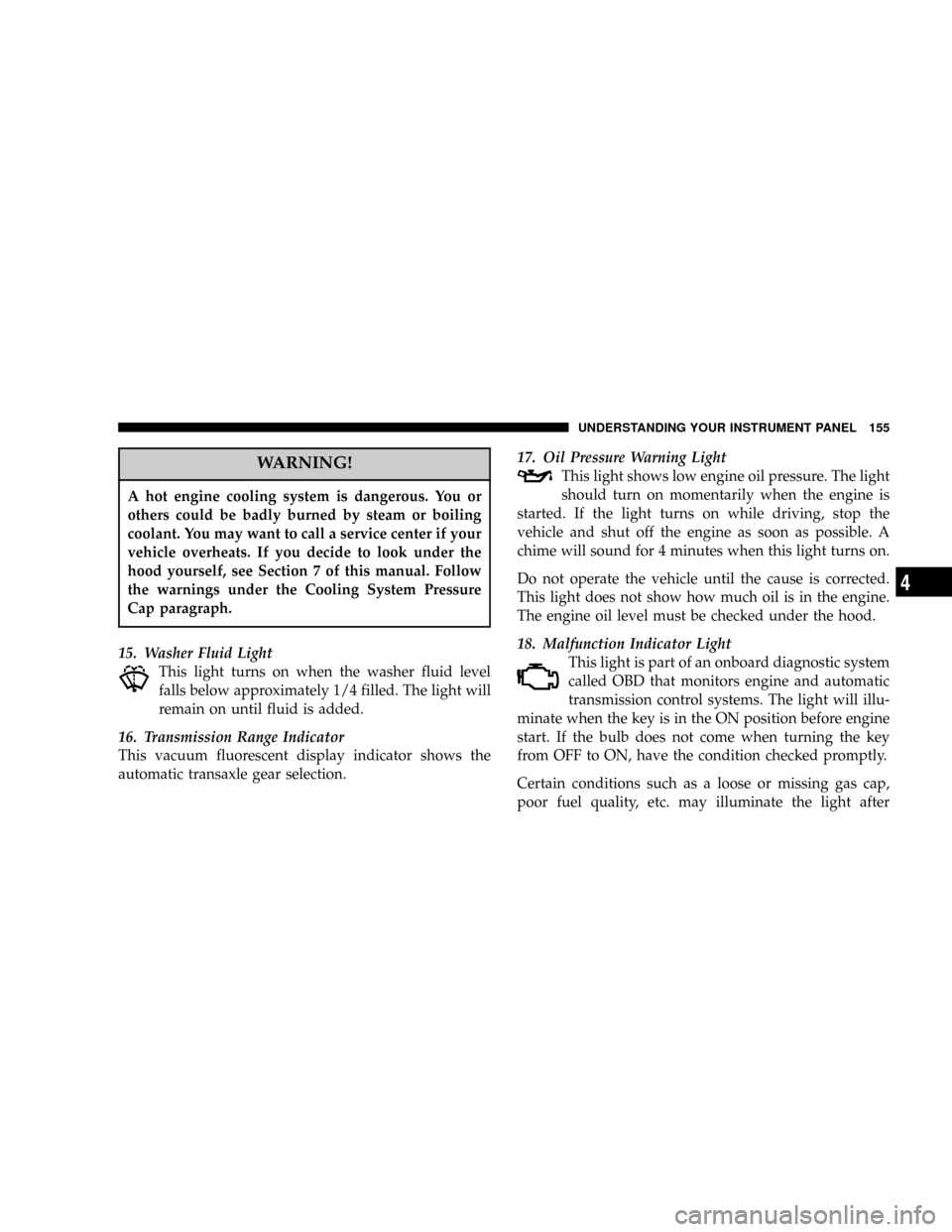
WARNING!
A hot engine cooling system is dangerous. You or
others could be badly burned by steam or boiling
coolant. You may want to call a service center if your
vehicle overheats. If you decide to look under the
hood yourself, see Section 7 of this manual. Follow
the warnings under the Cooling System Pressure
Cap paragraph.
15. Washer Fluid Light
This light turns on when the washer fluid level
falls below approximately 1/4 filled. The light will
remain on until fluid is added.
16. Transmission Range Indicator
This vacuum fluorescent display indicator shows the
automatic transaxle gear selection.17. Oil Pressure Warning Light
This light shows low engine oil pressure. The light
should turn on momentarily when the engine is
started. If the light turns on while driving, stop the
vehicle and shut off the engine as soon as possible. A
chime will sound for 4 minutes when this light turns on.
Do not operate the vehicle until the cause is corrected.
This light does not show how much oil is in the engine.
The engine oil level must be checked under the hood.
18. Malfunction Indicator Light
This light is part of an onboard diagnostic system
called OBD that monitors engine and automatic
transmission control systems. The light will illu-
minate when the key is in the ON position before engine
start. If the bulb does not come when turning the key
from OFF to ON, have the condition checked promptly.
Certain conditions such as a loose or missing gas cap,
poor fuel quality, etc. may illuminate the light after
UNDERSTANDING YOUR INSTRUMENT PANEL 155
4
Page 217 of 397

Bi-Level Mode
Air comes from both the headliner outlets and the
floor outlets.
NOTE:In many temperature positions, the bi-level
mode is designed to provide cooler air out of the head-
liner outlets and warmer air from the floor outlets.
Headliner Mode
Air comes from the outlets in the headliner. Each of
these outlets can be individually adjusted to direct
the flow of air. Moving the air vane knob on the outlets to
one side will shut off the air flow.
Summer Operation
The engine cooling system in air conditioned vehicles
must be protected with a high-quality antifreeze coolant
to provide proper corrosion protection and to protect
against engine overheating. A 50% solution of ethyleneglycol antifreeze coolant in water is recommended. Refer
to section 7, Maintenance Procedures, of this manual for
proper coolant selection.
Winter Operation
The air from the heater system will heat faster in cold
weather if you use only low blower speeds for the first 10
minutes of vehicle operation. Use of the air Recirculation
mode during winter months is not recommended be-
cause it may cause window fogging.
Vacation Storage
Anytime you store your vehicle, or keep it out of service
(i.e. vacation) for two weeks or more, run the air condi-
tioning system at idle for about five minutes in the fresh
air and high blower setting. This will insure adequate
system lubrication to minimize the possibility of com-
pressor damage when the system is started again.
UNDERSTANDING YOUR INSTRUMENT PANEL 217
4
Page 282 of 397
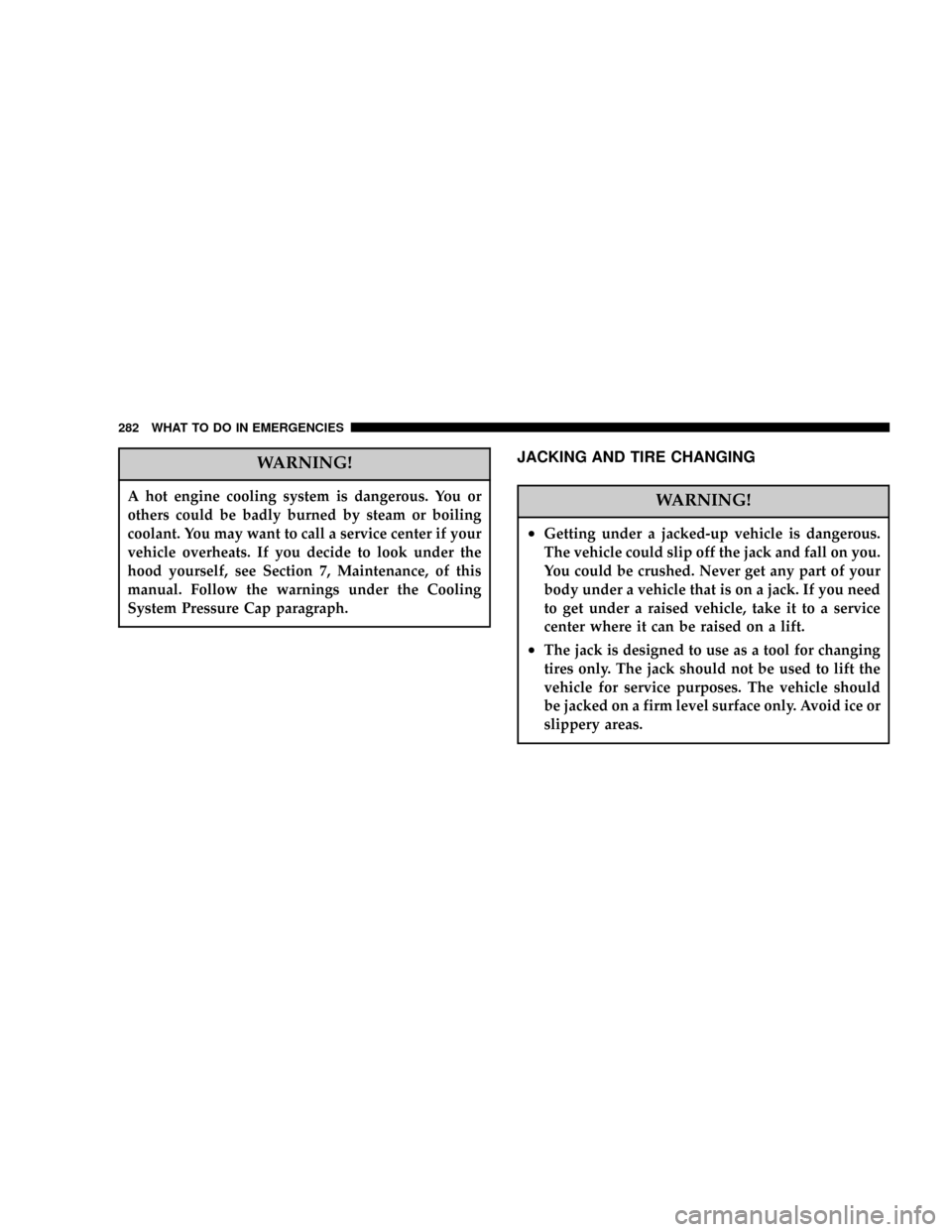
WARNING!
A hot engine cooling system is dangerous. You or
others could be badly burned by steam or boiling
coolant. You may want to call a service center if your
vehicle overheats. If you decide to look under the
hood yourself, see Section 7, Maintenance, of this
manual. Follow the warnings under the Cooling
System Pressure Cap paragraph.
JACKING AND TIRE CHANGING
WARNING!
²Getting under a jacked-up vehicle is dangerous.
The vehicle could slip off the jack and fall on you.
You could be crushed. Never get any part of your
body under a vehicle that is on a jack. If you need
to get under a raised vehicle, take it to a service
center where it can be raised on a lift.
²The jack is designed to use as a tool for changing
tires only. The jack should not be used to lift the
vehicle for service purposes. The vehicle should
be jacked on a firm level surface only. Avoid ice or
slippery areas.
282 WHAT TO DO IN EMERGENCIES
Page 320 of 397
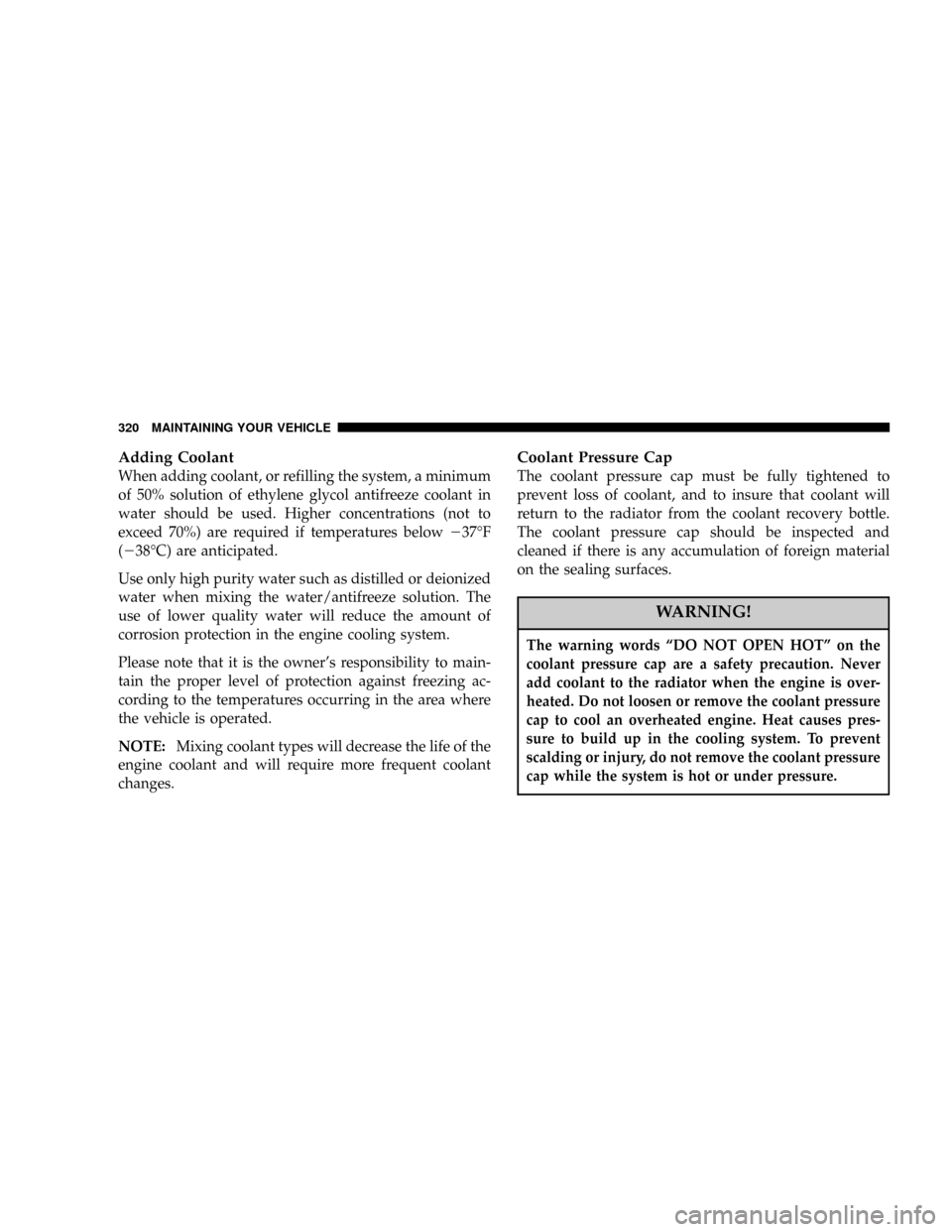
Adding Coolant
When adding coolant, or refilling the system, a minimum
of 50% solution of ethylene glycol antifreeze coolant in
water should be used. Higher concentrations (not to
exceed 70%) are required if temperatures below237ÉF
(238ÉC) are anticipated.
Use only high purity water such as distilled or deionized
water when mixing the water/antifreeze solution. The
use of lower quality water will reduce the amount of
corrosion protection in the engine cooling system.
Please note that it is the owner's responsibility to main-
tain the proper level of protection against freezing ac-
cording to the temperatures occurring in the area where
the vehicle is operated.
NOTE:Mixing coolant types will decrease the life of the
engine coolant and will require more frequent coolant
changes.
Coolant Pressure Cap
The coolant pressure cap must be fully tightened to
prevent loss of coolant, and to insure that coolant will
return to the radiator from the coolant recovery bottle.
The coolant pressure cap should be inspected and
cleaned if there is any accumulation of foreign material
on the sealing surfaces.
WARNING!
The warning words ªDO NOT OPEN HOTº on the
coolant pressure cap are a safety precaution. Never
add coolant to the radiator when the engine is over-
heated. Do not loosen or remove the coolant pressure
cap to cool an overheated engine. Heat causes pres-
sure to build up in the cooling system. To prevent
scalding or injury, do not remove the coolant pressure
cap while the system is hot or under pressure.
320 MAINTAINING YOUR VEHICLE
Page 321 of 397

Disposal of Used Engine Coolant
Used ethylene glycol based engine coolant is a regulated
substance requiring proper disposal. Check with your
local authorities to determine the disposal rules for your
community. To prevent ingestion by animals or children
do not store ethylene glycol based engine coolant in open
containers or allow it to remain in puddles on the
ground. If ingested by a child, contact a physician
immediately. Clean up any ground spills immediately.
Coolant Level
The coolant recovery bottle provides a quick visual
method for determining that the coolant level is ad-
equate. With the engine cold, the level of the coolant in
the coolant recovery bottle should be between the
ªMAXº and ªMINº marks. The radiator normally re-
mains completely full, so there is no need to remove the
radiator cap except for checking coolant freeze point or
replacement with new antifreeze coolant. Your service
attendant should be advised of this. So long as the engineoperating temperature is satisfactory, the coolant recov-
ery bottle need only be checked once a month.
When additional coolant is needed to maintain the
proper level, it should be added to the coolant recovery
bottle. Do not overfill.
Points to Remember
NOTE:When the vehicle is stopped after a few miles of
operation, you may observe vapor coming from the front
of the engine compartment. This is normally a result of
moisture from rain, snow, or high humidity accumulat-
ing on the radiator and being vaporized when the
thermostat opens, allowing hot water to enter the radia-
tor.
If an examination of your engine compartment shows no
evidence of radiator or hose leaks, the vehicle may be
safely driven. The vapor will soon dissipate.
²Do not overfill the coolant recovery bottle.
MAINTAINING YOUR VEHICLE 321
7
Page 322 of 397

²Check coolant freeze point in the radiator and in the
coolant recovery bottle. If antifreeze needs to be
added, contents of coolant recovery bottle must also be
protected against freezing.
²If frequent coolant additions are required, or if the
level in the coolant recovery bottle does not drop when
the engine cools, the cooling system should be pres-
sure tested for leaks.
²Maintain coolant concentration at 50% ethylene glycol
antifreeze (minimum) in water for proper corrosion
protection of your engine which contains aluminum
components.
²Make sure that the radiator and coolant recovery
bottle overflow hoses are not kinked or obstructed.
²Keep the front of the radiator clean. If your vehicle is
equipped with air conditioning, keep the front of the
condenser clean, also.
²Do not change the thermostat for summer or winter
operation. If replacement is ever necessary, install
ONLY the correct type thermostat. Other designs may
result in unsatisfactory cooling performance.
²Increasing engine speed at idle does not reduce cool-
ant temperature! Put transmission in NEUTRAL and
let engine idle at normal engine idle speed.
Hoses And Vacuum/Vapor Harnesses
Inspect surfaces of hoses and nylon tubing for evidence
of heat and mechanical damage. Hard or soft spots,
brittle rubber, cracking, tears, cuts, abrasions, and exces-
sive swelling indicate deterioration of the rubber.
Pay particular attention to those hoses nearest to high
heat sources such as the exhaust manifold. Inspect hose
routing to be sure hoses do not come in contact with any
heat source or moving component which may cause heat
damage or mechanical wear.
322 MAINTAINING YOUR VEHICLE
Page 343 of 397
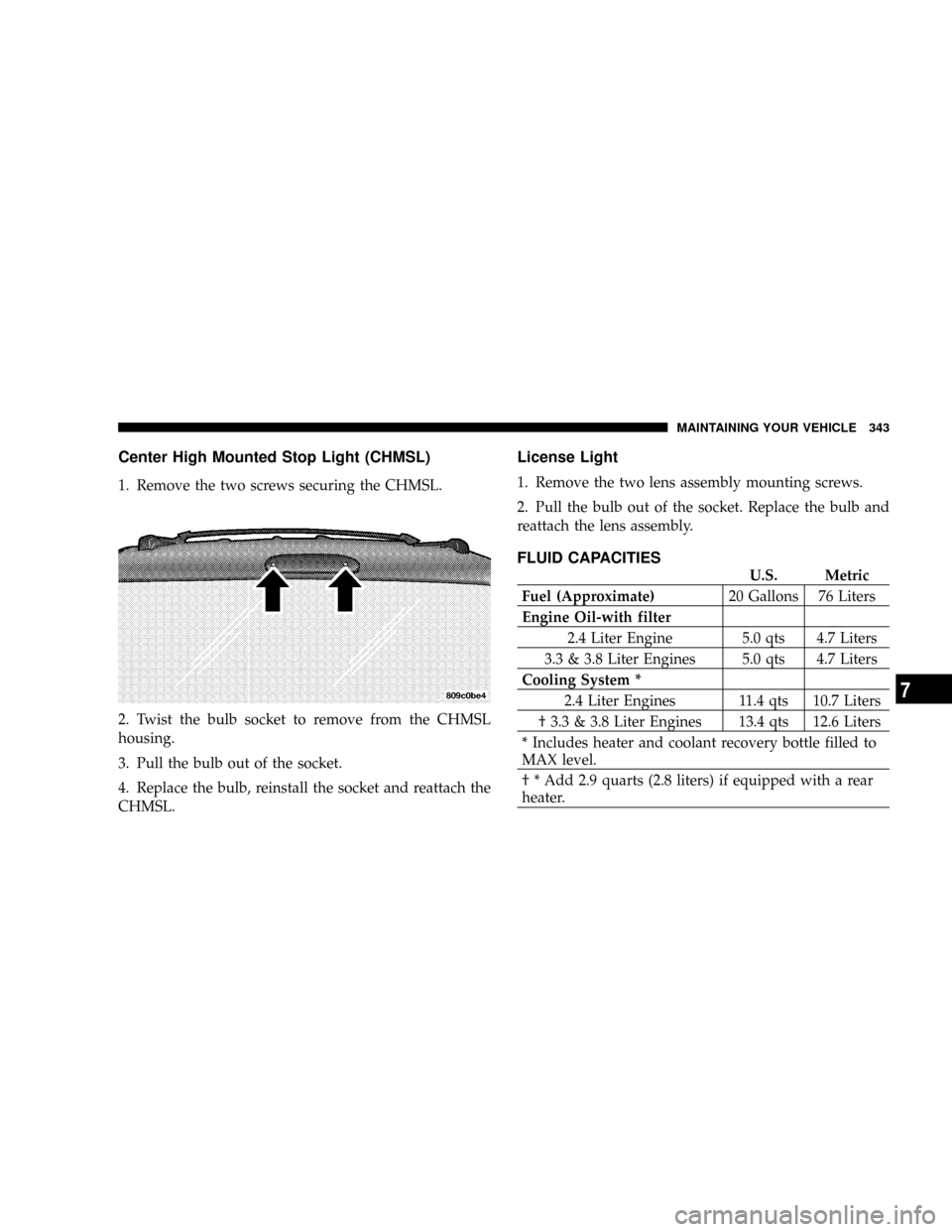
Center High Mounted Stop Light (CHMSL)
1. Remove the two screws securing the CHMSL.
2. Twist the bulb socket to remove from the CHMSL
housing.
3. Pull the bulb out of the socket.
4. Replace the bulb, reinstall the socket and reattach the
CHMSL.
License Light
1. Remove the two lens assembly mounting screws.
2. Pull the bulb out of the socket. Replace the bulb and
reattach the lens assembly.
FLUID CAPACITIES
U.S. Metric
Fuel (Approximate)20 Gallons 76 Liters
Engine Oil-with filter
2.4 Liter Engine 5.0 qts 4.7 Liters
3.3 & 3.8 Liter Engines 5.0 qts 4.7 Liters
Cooling System *
2.4 Liter Engines 11.4 qts 10.7 Liters
² 3.3 & 3.8 Liter Engines 13.4 qts 12.6 Liters
* Includes heater and coolant recovery bottle filled to
MAX level.
² * Add 2.9 quarts (2.8 liters) if equipped with a rear
heater.
MAINTAINING YOUR VEHICLE 343
7
Page 349 of 397
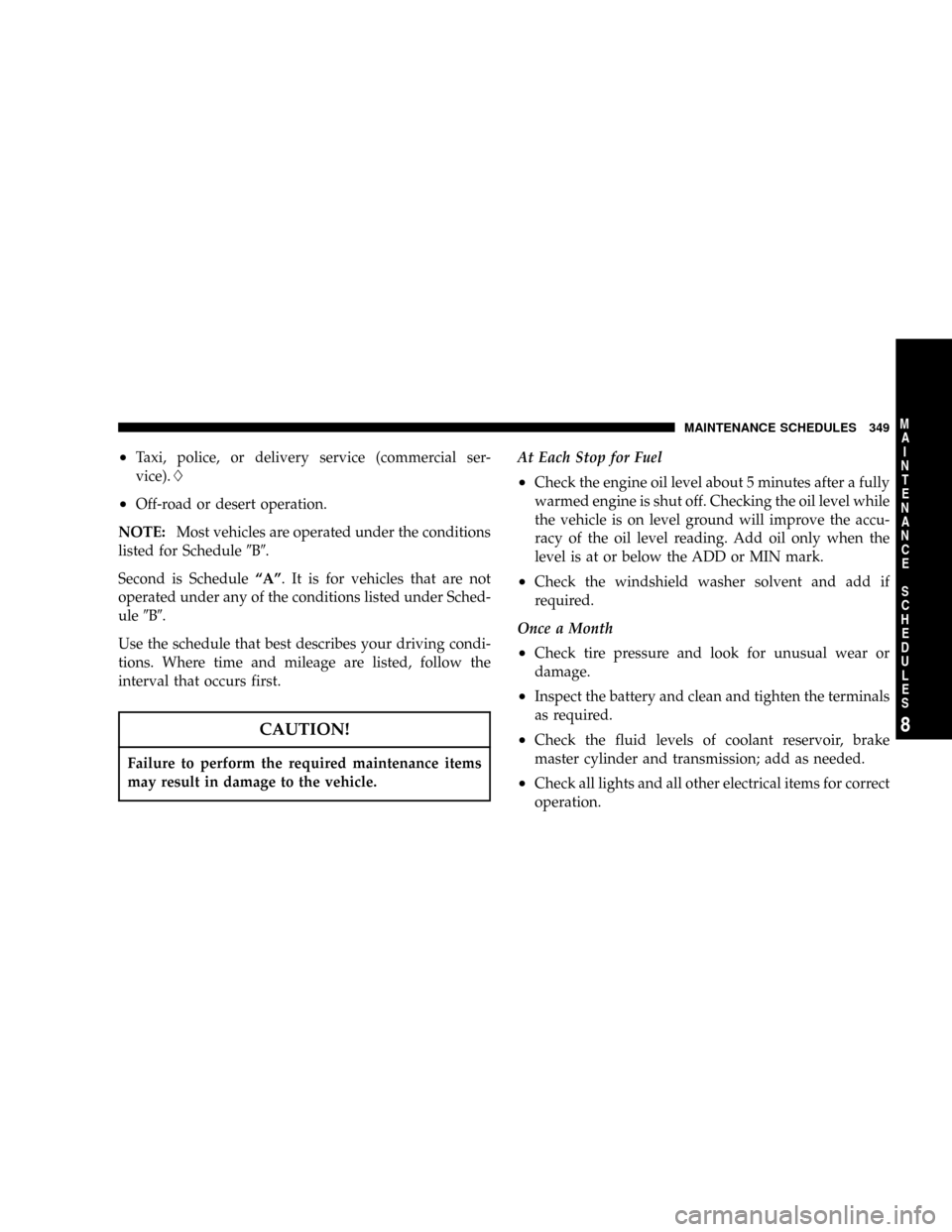
²Taxi, police, or delivery service (commercial ser-
vice).L
²Off-road or desert operation.
NOTE:Most vehicles are operated under the conditions
listed for Schedule9B9.
Second is ScheduleªAº. It is for vehicles that are not
operated under any of the conditions listed under Sched-
ule9B9.
Use the schedule that best describes your driving condi-
tions. Where time and mileage are listed, follow the
interval that occurs first.
CAUTION!
Failure to perform the required maintenance items
may result in damage to the vehicle.
At Each Stop for Fuel
²Check the engine oil level about 5 minutes after a fully
warmed engine is shut off. Checking the oil level while
the vehicle is on level ground will improve the accu-
racy of the oil level reading. Add oil only when the
level is at or below the ADD or MIN mark.
²Check the windshield washer solvent and add if
required.
Once a Month
²Check tire pressure and look for unusual wear or
damage.
²Inspect the battery and clean and tighten the terminals
as required.
²Check the fluid levels of coolant reservoir, brake
master cylinder and transmission; add as needed.
²Check all lights and all other electrical items for correct
operation.
MAINTENANCE SCHEDULES 349
8
M
A
I
N
T
E
N
A
N
C
E
S
C
H
E
D
U
L
E
S
Page 350 of 397
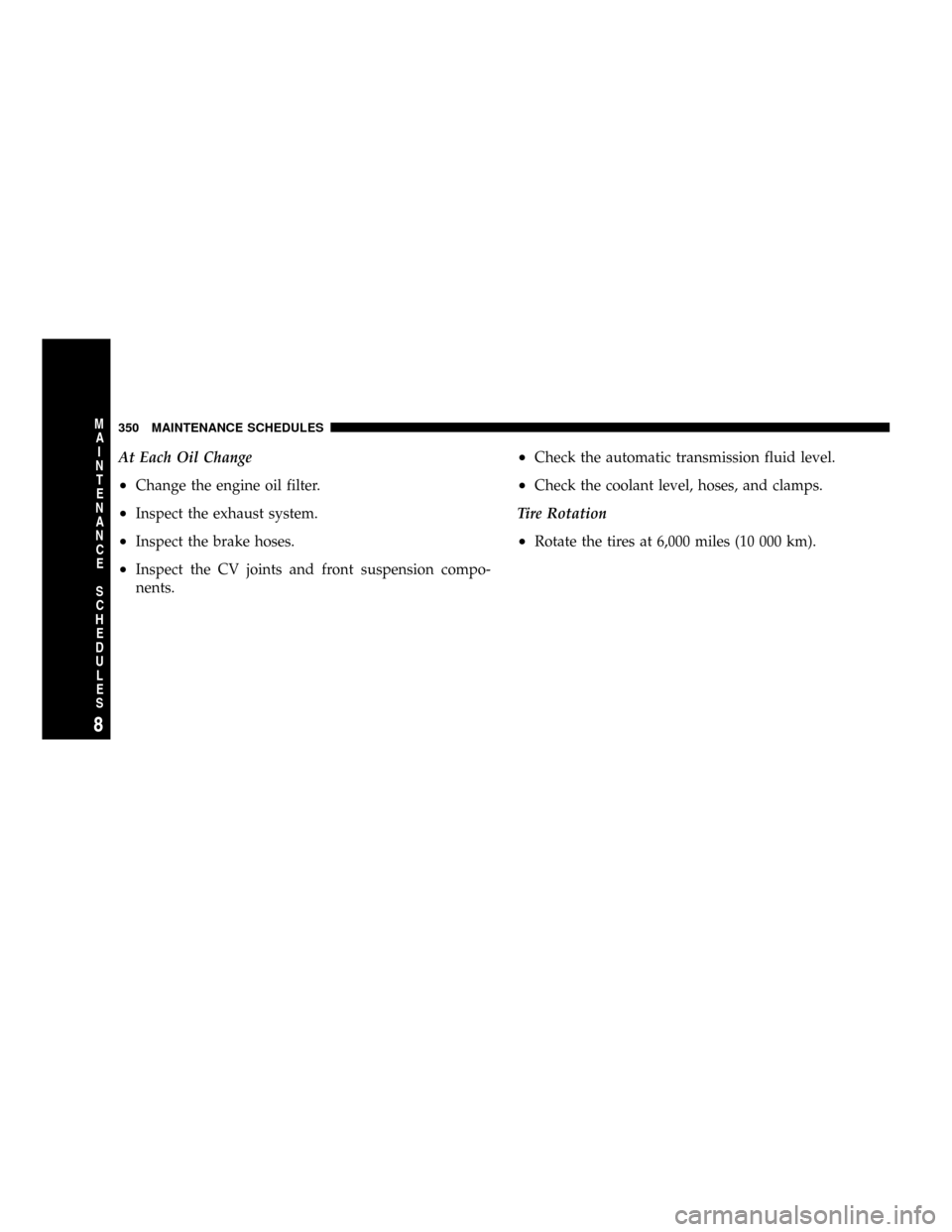
At Each Oil Change
²Change the engine oil filter.
²Inspect the exhaust system.
²Inspect the brake hoses.
²Inspect the CV joints and front suspension compo-
nents.
²Check the automatic transmission fluid level.
²Check the coolant level, hoses, and clamps.
Tire Rotation
²Rotate the tires at 6,000 miles (10 000 km).
350 MAINTENANCE SCHEDULES
8
M
A
I
N
T
E
N
A
N
C
E
S
C
H
E
D
U
L
E
S
Page 384 of 397

Cargo Compartment
Luggage Carrier....................... 139
Cassette Tape and Player Maintenance......... 197
Cassette Tape Player..................... 161
Catalytic Converter...................... 309
CD Changer......................170,182,187
CD Player...............167,171,174,178,180,187
Center High Mounted Stop Light............ 343
Center Lap Belts......................... 47
Chains, Tire............................ 263
Changing A Flat Tire..................... 282
Child Restraint.......................... 58
Child Restraint Tether Anchors............... 62
Child Safety Locks........................ 32
Child Seat............................58,64
Clean Air Gasoline....................... 266
Climate Control......................... 199
Clock................................ 159
Compact Disc Maintenance................. 198Compact Disc Player..................161,167
Compact Spare Tire...................... 255
Compass.............................. 111
Compass Calibration..................... 112
Compass Variance....................... 112
Computer, Trip/Travel.................... 114
Console, Overhead....................... 110
Console, Removable...................... 132
Contract, Service........................ 374
Coolant Pressure Cap..................... 320
Cooling System......................... 318
Adding Coolant (Antifreeze).............. 320
Coolant Capacity...................... 343
Coolant Level......................... 321
Disposal of Used Coolant................ 321
Drain, Flush, and Refill.................. 319
Inspection........................... 318
Points to Remember.................... 321
Pressure Cap......................... 320
384 INDEX